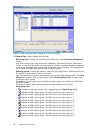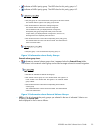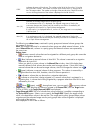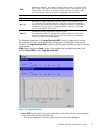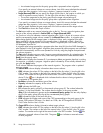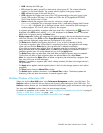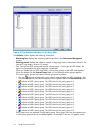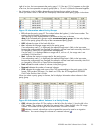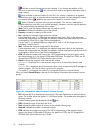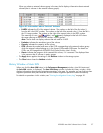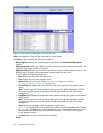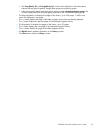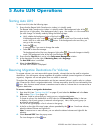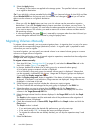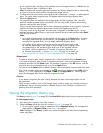
indicates a normal volume that can be migrated. If you change the attribute of this
volume to a reserved volume (
), this volume can be used as a migration destination (that is,
target volume).
(blue) indicates a reserved volume of Auto LUN. This volume is reserved as a migration
destination by Auto LUN. A reserved volume cannot be migrated. You can change this volume
to a normal volume (
), and then you can use this volume as a source volume.
(green) indicates a reserved volume of other programs. This volume is reserved by a
program other than Auto LUN (such as RAID Manager), therefore, Auto LUN cannot operation
it. You cannot change the attribute of this volume.
Note:
The list does not display volumes that are used as a LUSE.
• Emulation in
dicates the emulation type of the volume.
• Capacity indicates the capacity of the volume.
• Ave. indicates the average usage rate for the volume.
If an exclamation mark (!) is displayed, the reported usage rate is likely to be inaccurate,
because the configuration has changed (for example, volumes have been moved by Auto LUN
or changed
by Virtual LVI or Open Volume Management).
If a plus ma
rk (+) is displayed before a usage rate 0, such as +0, the usage rate is not
completely 0 but less than 1.
• Max. indicates the maximum usage rate for the volume.
If an exclamation mark (!) is displayed, the reported usage rate is likely to be inaccurate,
because the configuration has changed (for example, volumes have been moved by Auto LUN
or change
d by Virtual LVI or Open Volume Management).
• CLPR indicates the number and name of the CLPR corresponding to the parity group which
thevolumebelongs to, inthe format CLPR-number:CLPR-name.For details on CLPRs, see HP
StorageWorks XP24000 Disk/Cache Partition User’s Guide.
• Owner indicates the program which reserved this volume.
If XP24000 is displayed, this is the reserved volume which is reserved by Remote Web
Console
.
If Other[XX] is displayed, this is the reserved volume which is reserved by RAID Manager or
another program. XX is an ID which is given by this program.
If a hyphen (-)isdisplayed,thisvolumeisnot reserved andthisisanormal volume.
When you
select External Group in the tree, the list displays information about external volume
groups.
Figure 21 Information about External Volume Groups
• ExG in
dicates the ID of the external volume group. The letter E stands for an external volume
group
. The number before the hyphen (-)isthe framenumber. Thenumberafter thehyphenis
the group number.
External volume groups are displayed with the icon.
• HDD indicates thetypeofthe hard disk drive.
• Total indicates the total number of volumes in the external volume group.
• Reserved indicates the number of reserved volumes.
• CLPR indicates the number and name of the CLPR corresponding to the external volume
group in the format CLPR-number:CLPR-name. For details on CLPRs, see HP StorageWorks
XP24000 Disk/Cache Partition User’s Guide.
36
Using the Auto LUN GUI



